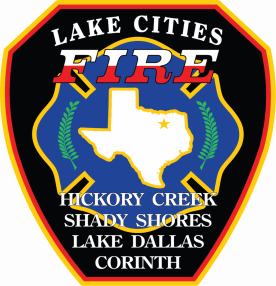Emergency Management Division
The Emergency Management Division is a coordinated effort that responds to large-scale emergencies or disasters that are either natural or manmade. Emergency management is broken down by federal, state, and local agencies. The federal level agency for such activities is the Federal Emergency Management Agency (FEMA), The state level agency is the Texas Division of Emergency Management (TDEM), in the Department of Public Safety, and the Lake Cities Fire Department Emergency Management Division is responsible for the local level. The purpose of Emergency Management is to coordinate the activities of various municipal departments and organizations responsible for continued operations during disasters, coordinate inter-local agreements for resource utilization, communicate with state and federal agencies, and provide education and training.
Ultimately, the Emergency Management mission is to increase the capabilities to respond to the hazard that threaten our area, all the while, preventing or reducing the impact of the hazards on the communities.
Functions of Emergency Management include:
- Capability Assessment
- Emergency Operation Center (EOC)
- Emergency Operation Plan (EOP) Development
- Functional Annex Development
- Hazard Analysis
- Public Education
- State and Federal Reporting
- Training
Emergency Management Model
There are four phases to the emergency management model:
- Mitigation- actions taken before an event occurs to prevent or lessen the impact the event has to life and property. Examples of mitigation include building codes, zoning ordinances, grant funding, and training.
- Preparedness- activities, actions, procurements, planning, training, and inter-jurisdictional cooperation designed to increase response readiness to identified hazards the community faces.
- Response- mobilization of resources to meet the needs of the community in response to the nature of the disaster. Mobilization includes local, county, state, and federal resources, as necessary. Response is usually associated with the period of time immediately after the event and necessary to ensure life safety issues are handled. Examples include fire and EMS services, search and rescue, debris removal, public works activities, and law enforcement.
- Recovery- long-term mobilization of support operations that work toward returning the community to its pre-event condition. This period is usually when social services and volunteer organizations tasked with relief effort gear up. The greater the magnitude of the disaster the greater the recovery effort.
Natural and Man-Made Emergencies
Natural Hazards
- Drought
- Earthquake
- Flash Flood
- Hurricane
- Tornado
- Wildfire
- Winter Storm
Man-Made (Technological) Hazards
- Biological Agents
- Disruptions in Services - Water, Sewer, Electrical Power, Communications, Travel, etc.
- Hazardous Materials
- Mass Gatherings
- Transportation – Airline, Truck, and Rail
- Weapons of Mass Destruction


